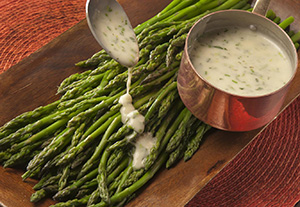
50-Minute Classroom: Sauces
03 August 2015If you think you can’t teach sauces within a 50-minute context, you absolutely can, says Chef Weiner. But first, you need to prep … yourself.
By Adam Weiner, CFSE
Sauces can greatly elevate a dish. A poached egg is nothing special. Take that poached egg and put it in a muffin and add a slice of ham and you have a breakfast sandwich served throughout the country at countless fast-food places. Place that poached egg on top of an English muffin with a slice of ham and add hollandaise sauce, and you have something wonderful.
Many teachers believe that sauces can’t be taught in a 50-minute context. They can be, but you need to get some sauce basics first.
A. What Is a Sauce?
A sauce is nothing more than a flavorful liquid that is thickened and seasoned.
B. What Is the Purpose of a Sauce?
Most new cooks over-sauce the food, believing that the sauce is the key to a fine and fancy plate. The real purpose of a sauce or gravy is to accent the food. Sauces also give a little extra pizzazz and color to the plate. Sauces are NOT designed to overpower the food nor cover up bad food. The main ingredient is the main thing that you want to feature. The sauce should enhance the main ingredient—not overpower or bury it.
C. Why Is the Liquid So Important?
The most important thing in making a sauce is the quality and flavor of the liquid. No matter how good you are at thickening, seasoning and finishing, you will never have anything great come out of plain water.
Almost all of the sauces that your class will make start with one of five different liquids:
- Stock
- Milk or cream
- Butter (usually clarified)
- Wine or other alcohol
- Tomatoes plus a liquid
 D. How Are Sauces Thickened?
D. How Are Sauces Thickened?
If the flavorful liquid is not thickened, all it will do is puddle on the bottom of the plate. It might taste good (think of a French Dip sandwich with au jus), but it won’t be a sauce. Sauces need to be thickened, but not overly thickened. Coating the back of a spoon is good. Something the consistency of paste isn’t. Unless there are solid elements in the sauce, such as mushrooms, the sauce should be smooth.
1. Adding Thickening Agents to the Liquid
Generally speaking, thickening agents are combined with a little of the selected liquid or a little bit of water to form a slurry or paste. If the liquid and the thickeners are combined and left uncooked, they are called a slurry (like cornstarch dissolved in water). If the thickener and the liquid are cooked together to form the paste, you have a roux. (Butter and flour are the most common two ingredients for a roux.)
- Basically, you will almost never add the thickening agent directly to the liquid that is going to be made into a sauce. The thickening agent won’t dissolve and you will end up with bumps and lumps of uncooked flour or cornstarch. You will almost always make a slurry or roux first. (Major exceptions include beurre manié, which is a combination of softened butter and flour combined in equal parts, and some commercial thickening agents.)
- Never have the slurry or roux at the same temperature as the flavorful liquid. If the liquid is warm or hot the slurry/roux should be at room temperature or cooler. If the slurry/roux is warm or hot the flavorful liquid should be at room temperature or cooler.
- The thickening agent does not come into full force until the flavorful liquid to which it has been added is heated to nearly boiling. When you combine the slurry or roux with the flavorful liquid, the liquid thickens up more as you heat it. In my early days of making sauces, I would be concerned that the liquid wasn’t thick enough after adding the slurry or roux. I would add more and more and when the sauce came nearly to a boil it would be of a consistency only seen in movies right before the dinosaur gets trapped.
2. Types of Thickening Agents
- Flour is the most common. It is cheap and found in every kitchen. It can be used in slurries and roux.
- Cornstarch yields a shiny, almost clear, sauce. It has nearly twice the thickening power of flour, but is more expensive.
- Arrowroot is a wonderful thickening agent yielding a very clear sauce. The problem is that it is very expensive.
- Breadcrumbs work well as a thickening agent for sauces that don’t require a perfectly smooth texture
- Commercial instant thickening starches are okay, but you must be careful to follow the directions.
- Egg yolks can work to slightly thicken a sauce and add a wonderful flavor. It is critical to follow the proper procedure (called tempering), or you will end up with scrambled eggs in your liquid. If the sauce calls for adding egg yolks, you need to add a little of the hot liquid to the eggs and whisk. This is called tempering when you temper the eggs up to temperature. If you don’t do this, you will cook the eggs and have scrambled eggs in the sauce. After you have tempered the eggs, you can add them to the rest of the liquid and heat the sauce.
E. How Are Sauces Finished?
The purpose of finishing a sauce is to take the three parts (thickener, seasoning and thickening agent) and combine them into the sauce
- Reduction: The most common way to finish a sauce is by reduction. When you reduce a liquid you put it in a pan and simmer it. Although you will be simmering away some flavor most of what you will simmering always is the water in the liquid which has no flavor.
- Adding liquid: the opposite of reduction. You add a little more liquid at the end of sauce making process. Sherry, alcohol, lemon juice and butter and cream are common for this purpose.
- Straining: Even though your sauce seems perfectly smooth, most sauces could benefit from being strained through a fine strainer lined with cheesecloth to remove any undissolved particles.
- Seasoning: This is the FINAL step in sauce making. Don’t season early, because as you reduce the sauce, you will concentrate the seasonings. Adding salt (or pepper or even dill, or garlic powder, or coriander) at the beginning may end up with a sauce that is so salty you can’t eat it after the liquid has been reduced. Speaking of pepper, if the sauce is light in color, always use white peeper instead of black pepper. White pepper is less flavorful and more expensive, so only use it when black spots would be seen in the sauce otherwise. (For example, black pepper in tomato sauce and white pepper in a cream sauce.)
F. What Are the Mother Sauces?
The mother sauces are the key sauces from which almost all Continental sauces are made
- Hollandaise: butter and egg yolks
- Tomato Sauce: tomatoes plus stock
- Espagnole (Brown Sauce): brown stock thickened with a brown roux
- Béchamel: milk combined with a white roux.
- Velouté: white stock combined with a blond roux or possibly a white roux. The stock can be veal, chicken or fish.
In summary, a sauce will add color, texture and flavor to your food. In preparing sauces the most important things to remember are:
- The sauce should have a nice flavor and not be lumpy
- The sauce should be thick enough to coat the food, but not thick enough to be a paste
- The sauce should have a distinct flavor, not be overly seasoned and not taste starchy. The taste should complement the food and not overpower the food. The sauce should not cover up the food
Chef Adam Weiner, CFSE, teaches a 20-week Introduction to Cooking program for JobTrain on the San Francisco Peninsula, and is a frequent presenter at CAFÉ events throughout the nation.
PHOTO:This tarragon/chive butter sauce created by Chef Christopher Koetke, CEC, CCE, HAAC, vice president of the Kendall College School of Culinary Arts in Chicago, tastes much like classic beurre blanc, but is much easier to make. Like beurre blanc, this sauce takes advantage of butter’s inherent emulsification abilities.Download attachments:
- Download: Kendall (50 Downloads)
